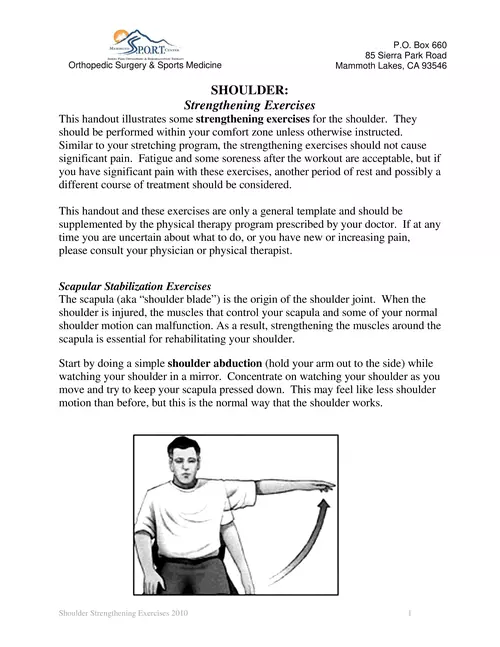
SHOULDER: Strengthening Exercises - Mammoth Orthopedic Institute
(upper arm bone), the tendons of the rotator cuff that Your doctor may send you to a physical therapist for exercises or other therapy.
adsPart of the document
Orthopedic Surgery & Sports MedicineP.O. Box 660
85 Sierra Park Road
Mammoth Lakes, CA 93546
Shoulder Strengthening Exercises 20101
SHOULDER:
Strengthening Exercises
This handout illustrates some strengthening exercisesfor the shoulder. They
should be performed within your comfort zone unless otherwise instructed.
Similar to your stretching program, the strengthening exercises should not cause
significant pain. Fatigue and some soreness after the workout are acceptable, but if
you have significant pain with these exercises, another period of rest and possibly a
different course of treatment should be considered.
This handout and these exercises are only a general template and should be
supplemented by the physical therapy program prescribed by your doctor. If at any
time you are uncertain about what to do, or you have new or increasing pain,
please consult your physician or physical therapist.
Scapular Stabilization Exercises
The scapula (aka "shoulder blade") is the origin of the shoulder joint. When the
shoulder is injured, the muscles that control your scapula and some of your normal
shoulder motion can malfunction. As a result, strengthening the muscles around the
scapula is essential for rehabilitating your shoulder.
Start by doing a simple
shoulder abduction(hold your arm out to the side) while
watching your shoulder in a mirror. Concentrate on watching your shoulder as you
move and try to keep your scapula pressed down. This may feel like less shoulder
motion than before, but this is the normal way that the shoulder works.
Orthopedic Surgery & Sports Medicine
Shoulder Strengthening Exercises 20102
Scapular Protraction
Lie on your back and, while holding a
small dumb-bell in front of you, push
the shoulder forward while keeping
your arm as still as possible.
You can also do this against a wall,
like a wall push-up. Do not bend
your elbows, but instead move your
scapula forward and back.
Wall Push-ups
Place your palms flat on the wall,
shoulder-width apart. Bend your
elbows and slowly lower yourself
toward the wall. Pause, then slowly
push yourself back until your arms
are straight.
(Be careful not to round
or arch your back while doing this.)
Orthopedic Surgery & Sports Medicine
Shoulder Strengthening Exercises 20103
Shoulder Shrugs
Holding a light dumb-bell at your side, shrug
your shoulder upwards to elevate the weight.
Orthopedic Surgery & Sports Medicine
Shoulder Strengthening Exercises 20104
Infraspinatus Strengthening
(Posterior Rotator Cuff)
Three exercises are shown:A:
Isometric contraction.Stand with the
involved side of your body against a
wall. Bend your elbow to 90° and push
your arm into the wall. Your arm should
not move. Hold for 5 seconds, then relax.
(This is very low stress and well-
tolerated in the injured or post-op
shoulder).
B:Tubing Pulls.Externally rotate your
arm while holding your rubber band or
stretch tubing in the other arm. The band
generates resistance for your
infraspinatus muscle.
C:
Dumbell.Lie on your other side. Keep
your elbow bent at 90° and at your side.
Rotate your hand away from your body
(against gravity), then slowly lower back
down.
Orthopedic Surgery & Sports Medicine
Shoulder Strengthening Exercises 20105
Subscapularis Strengthening
(Anterior Rotator Cuff)
Three exercises are shown:
A:
Isometric contraction.Stand at the
corner of a wall or door frame. Place
your arm against the wall, around the
corner. Keep your elbow bent to 90°.
Push your arm into the wall and hold
for 5 seconds, then relax. Your arm
should not move.
(This is very low
stress and well-tolerated in the injured
or post-op shoulder)
B: Tubing Pulls.Tie your rubber band
or stretch tubing to a doorknob or
table. Rotate your arm toward your
body. The tubing generates resistance
for your subscapularis muscle.
C:
Dumbell. Lie on the same side and
keep your elbow bent to 90°. Raise
your hand up against gravity towards
your stomach. Slowly lower your hand
down.


